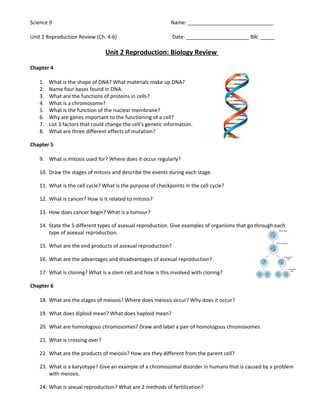Sci 9 - Ch. 4-6 Reproduction Unit Review
- 1. Science 9 Name: ______________________________ Unit 2 Reproduction Review (Ch. 4-6) Date: ______________________ Blk: _____ Unit 2 Reproduction: Biology Review Chapter 4 1. What is the shape of DNA? What materials make up DNA? 2. Name four bases found in DNA. 3. What are the functions of proteins in cells? 4. What is a chromosome? 5. What is the function of the nuclear membrane? 6. Why are genes important to the functioning of a cell? 7. List 3 factors that could change the cell’s genetic information. 8. What are three different effects of mutation? Chapter 5 9. What is mitosis used for? Where does it occur regularly? 10. Draw the stages of mitosis and describe the events during each stage. 11. What is the cell cycle? What is the purpose of checkpoints in the cell cycle? 12. What is cancer? How is it related to mitosis? 13. How does cancer begin? What is a tumour? 14. State the 5 different types of asexual reproduction. Give examples of organisms that go through each type of asexual reproduction. 15. What are the end products of asexual reproduction? 16. What are the advantages and disadvantages of asexual reproduction? 17. What is cloning? What is a stem cell and how is this involved with cloning? Chapter 6 18. What are the stages of meiosis? Where does meiosis occur? Why does it occur? 19. What does diploid mean? What does haploid mean? 20. What are homologous chromosomes? Draw and label a pair of homologous chromosomes. 21. What is crossing over? 22. What are the products of meiosis? How are they different from the parent cell? 23. What is a karyotype? Give an example of a chromosomal disorder in humans that is caused by a problem with meiosis. 24. What is sexual reproduction? What are 2 methods of fertilization?
- 2. 25. What is pollination? 26. Describe embryonic development and how mitosis is related. 27. What is differentiation? When is an embryo a fetus? 28. What are the advantages and disadvantages of sexual reproduction? 29. Where does fertilization take place in humans? 30. What are the structures in males and females that go through meiosis? 31. What is infertility? What is artificial insemination? What is in vitro fertilization? 32. What is embryo screening? Why is it used? 33. What is amniocentesis? Vocabulary Please know the following terms from Chapters 4-6: cell cell membrane cell wall nucleolus protein DNA RNA rough endoplasmic golgi body mitochondria reticulum vacuole/vesicle centriole nuclear membrane nucleotide double helix mutation positive/neutral/ gene ribosome mutagen negative mutation gene therapy chloroplast binary fission budding cancer cell cycle chromosomes nucleus embryonic fertilization development fragmentation gametes genes meiosis mitosis sexual and asexual stem cells vegetative zygote sperm and egg reproduction reproduction dominant recessive allele genotype phenotype heredity genetics testes vas deferens epididymis ovaries oviduct uterus vagina assisted reproductive technologies

